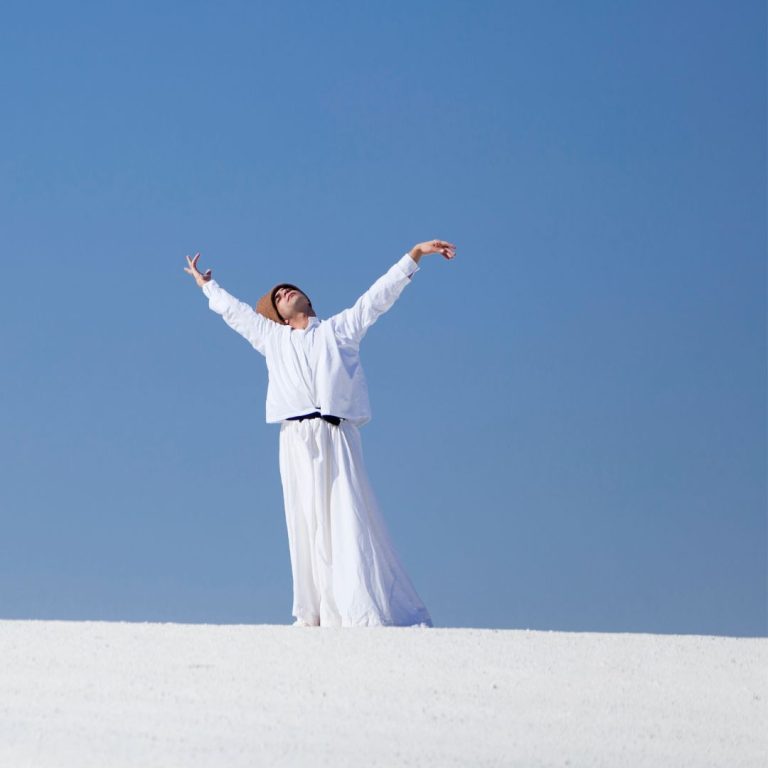

Home » Weekly Blog » Egypt’s Whirling Dervishes: Understanding Sufi Spirituality and Dance
In the heart of Egypt’s rich cultural tapestry lies a captivating and deeply spiritual tradition: the Whirling Dervishes. These mesmerizing dancers, known for their graceful rotations and entrancing performances, are more than just performers; they are custodians of Sufi spirituality and a testament to the enduring legacy of mysticism in Egyptian society. This blog post embarks on a journey to unravel the mystique surrounding Egypt’s Whirling Dervishes, delving into their historical origins, the significance of their dance, and the timeless wisdom it imparts.

Sufism: Sufism, a mystical branch of Islam, emphasizes the inner journey towards divine love and knowledge. Rooted in the teachings of the Quran and the Hadith, Sufism delves deep into the spiritual dimensions of Islam, seeking to attain closeness to the divine through meditation, introspection, and devotion. In Egypt, Sufism has played a pivotal role in shaping the country’s spiritual landscape and fostering a connection with the divine that transcends religious boundaries.
Historical Context: Sufism found fertile ground in Egypt due to its historical significance as a crossroads of cultures, religions, and ideas. The country’s geographical location and cultural diversity contributed to the flourishing of Sufi orders, each with its distinct practices and teachings. Over the centuries, Sufism became an integral part of Egypt’s social fabric, blending harmoniously with the existing religious traditions.
The Mevlevi Order: At the heart of the Whirling Dervishes’ tradition is the Mevlevi Order, founded in the 13th century by the esteemed Persian poet and mystic, Mevlana Jalaluddin Rumi. Rumi’s teachings emphasize the universality of love and the quest for spiritual union with the divine. His poetry, particularly the Mathnawi, offers profound insights into the Sufi path, which the Whirling Dervishes embody through their dance.
Rumi’s Influence: Rumi’s poetry and philosophy laid the groundwork for the Whirling Dervishes’ practices. His concept of “semazen,” or the Whirling Dervish, as a lover of God, seeking the ecstasy of union, became central to the dance’s symbolism. Rumi’s teachings encouraged individuals to transcend the physical realm through devotion, meditation, and the whirl, ultimately experiencing a state of spiritual awakening.
Connection Between Sufism and the Whirling Dervishes: The Whirling Dervishes’ dance is not merely a performance; it is a sacred ritual that encapsulates the core principles of Sufism. The act of spinning is a metaphor for the cosmic dance of creation, symbolizing the soul’s journey towards unity with the divine source. The repetitive motion reflects the cyclical nature of existence and the eternal nature of the divine.

Describing the Dance: The Whirling Dervishes’ dance is an intricate choreography of movements, where participants spin in a meditative trance. As they whirl, their arms are outstretched—one hand raised towards the sky to receive divine blessings and the other hand turned downwards, channeling those blessings to the earth. The dance is accompanied by music and poetry, creating an immersive sensory experience.
The Spiritual Journey Within the Dance: The act of whirling serves as a gateway to heightened consciousness. As the dancers spin, they enter a state of trance that allows them to detach from the material world and connect with the spiritual realm. This trance state is characterized by a sense of timelessness, where the dancers experience a profound connection with the divine presence.
Music and Poetry: Music and poetry are integral components of the Whirling Dervishes’ performance. The rhythmic melodies and poetic verses enhance the dancers’ spiritual experience, facilitating a deeper connection with the divine. The poetry often draws from Rumi’s verses, intertwining his wisdom with the physical embodiment of the dance.
The Dancer’s Attire: The Whirling Dervishes’ distinctive attire holds symbolic significance. The tall conical hat represents the tombstone of the ego, while the white robe symbolizes purity and spiritual rebirth. The wide skirt mirrors the embrace of the divine, while the color of the skirt reflects different stages of the spiritual journey.
The Dance as a Cosmic Journey: The Whirling Dervishes’ dance mirrors the cosmic journey of the soul towards unity with the divine. The spinning motion represents the rotation of celestial bodies and the cyclical nature of existence. It’s a reminder that every rotation brings the dancer closer to spiritual enlightenment and divine union.
Symbolism of Rotation: The act of spinning holds multiple layers of symbolism. It signifies the turning of the seeker’s heart towards God, the shedding of worldly attachments, and the dissolution of the ego. Moreover, the dancers’ rotation is a representation of the universal harmony and order orchestrated by the divine creator.
Modern Challenges: In the face of modernization, globalization, and changing social norms, Sufi practices, including the Whirling Dervishes’ rituals, are confronting challenges to their continuity. The rapid pace of urbanization and the influence of external cultures pose a potential threat to the preservation of these timeless traditions.
Preservation Efforts: Various organizations, scholars, and enthusiasts are dedicated to preserving the Sufi heritage of Egypt. Cultural initiatives, festivals, and workshops aim to raise awareness about the significance of Sufism and the Whirling Dervishes’ dance. These efforts play a crucial role in ensuring that the spiritual essence of this tradition remains alive for future generations.
Visiting Sufi Gatherings: For those eager to witness the Whirling Dervishes’ mesmerizing dance, Egypt offers opportunities to attend Sufi gatherings. One of the most renowned venues is the Al-Ghouri Complex in Cairo, where weekly performances take place. These gatherings provide a glimpse into the spiritual world of the Whirling Dervishes and offer a chance to partake in their transcendent journey.
Etiquette and Respect: Attending a Sufi performance requires a respectful and open-minded attitude. Observers should adhere to the guidelines provided by the organizers, which might include dressing modestly and refraining from photography during the sacred rituals. Respecting the spiritual space fosters an atmosphere of reverence and connection.
Personal Reflections: As a witness to the Whirling Dervishes’ dance, one can’t help but be moved by the dancers’ devotion and the ethereal atmosphere they create. The dance’s hypnotic rhythm and the participants’ fervent dedication inspire deep contemplation about the interconnectedness of humanity and the divine.

In Egypt’s Whirling Dervishes, we find a convergence of spirituality, culture, and history that transcends time and boundaries. The dance is a spiritual journey, a cosmic embrace, and a profound expression of devotion—all rolled into one mesmerizing spectacle. As we reflect on the significance of the Whirling Dervishes, we are reminded that the pursuit of divine love and union is a universal quest that unites humanity across cultures and faiths. By embracing and cherishing this rich tradition, we honor the
Sign up to hear about our upcoming adventures, monthly newsletter, exclusive offers, and more!
Required*
Not Ready to book?
Get regular updates on upcoming tour and special promotions.







Sign up for our Mailing List to get updates on our current offerings.

We look forward to seeing you on one of our tours!